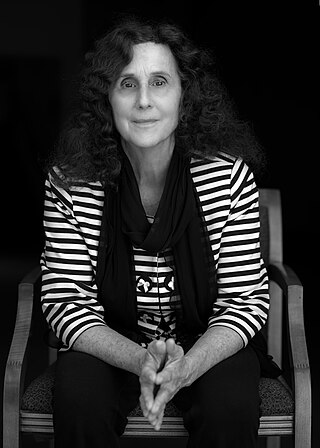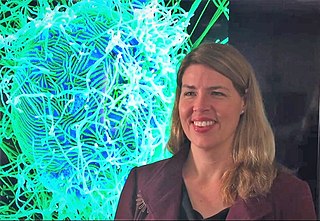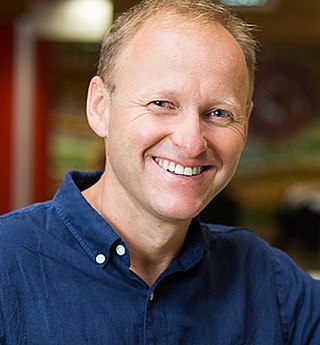Related Research Articles

Pamela Jane Bjorkman NAS, AAAS is an American biochemist. She is the David Baltimore Professor of Biology and Biological Engineering at the California Institute of Technology (Caltech), Her research centers on the study of the three-dimensional structures of proteins related to Class I MHC, or Major Histocompatibility Complex, proteins of the immune system and proteins involved in the immune responses to viruses. Bjorkman is most well known as a pioneer in the field of structural biology.

Chi-Huey Wong is a Taiwanese-American biochemist. He is currently the Scripps Family Chair Professor at the Scripps Research Institute, California in the department of chemistry. He is a member of the United States National Academy of Sciences, as awarded the 2014 Wolf Prize in Chemistry and 2015 RSC Robert Robinson Award. Wong is also the holder of more than 100 patents and publisher of more 700 scholarly academic research papers under his name.
Ian Andrew Wilson is the Hansen Professor of Structural Biology and chair of the Department of Integrative Structural and Computational Biology at the Scripps Research Institute in San Diego, California, United States.
Pseudotyping is the process of producing viruses or viral vectors in combination with foreign viral envelope proteins. The result is a pseudotyped virus particle, also called a pseudovirus. With this method, the foreign viral envelope proteins can be used to alter host tropism or increase or decrease the stability of the virus particles. Pseudotyped particles do not carry the genetic material to produce additional viral envelope proteins, so the phenotypic changes cannot be passed on to progeny viral particles. In some cases, the inability to produce viral envelope proteins renders the pseudovirus replication incompetent. In this way, the properties of dangerous viruses can be studied in a lower risk setting.

Betacoronavirus is one of four genera of coronaviruses. Member viruses are enveloped, positive-strand RNA viruses that infect mammals. The natural reservoir for betacoronaviruses are bats and rodents. Rodents are the reservoir for the subgenus Embecovirus, while bats are the reservoir for the other subgenera.

Erica Ollmann Saphire is an American structural biologist and immunologist and a professor at the La Jolla Institute for Immunology. Her research investigates the structural biology of viruses that cause hemorrhagic fever such as Ebola, Sudan, Marburg, Bundibugyo, and Lassa. She was awarded the Presidential Early Career Award for Scientists and Engineers in 2008.

Kizzmekia "Kizzy" Shanta Corbett is an American viral immunologist. She is an Assistant Professor of Immunology and Infectious Diseases at Harvard T.H. Chan School of Public Health and the Shutzer Assistant Professor at the Harvard Radcliffe Institute since June 2021.

Glycan-Protein interactions represent a class of biomolecular interactions that occur between free or protein-bound glycans and their cognate binding partners. Intramolecular glycan-protein (protein-glycan) interactions occur between glycans and proteins that they are covalently attached to. Together with protein-protein interactions, they form a mechanistic basis for many essential cell processes, especially for cell-cell interactions and host-cell interactions. For instance, SARS-CoV-2, the causative agent of COVID-19, employs its extensively glycosylated spike (S) protein to bind to the ACE2 receptor, allowing it to enter host cells. The spike protein is a trimeric structure, with each subunit containing 22 N-glycosylation sites, making it an attractive target for vaccine search.
Jason S. McLellan is a structural biologist, professor in the Department of Molecular Biosciences and Robert A. Welch Chair in Chemistry at The University of Texas at Austin who specializes in understanding the structure and function of viral proteins, including those of coronaviruses. His research focuses on applying structural information to the rational design of vaccines and other therapies for viruses, including SARS-CoV-2, the novel coronavirus that causes COVID-19, and respiratory syncytial virus (RSV). McLellan and his team collaborated with researchers at the National Institute of Allergy and Infectious Diseases’ Vaccine Research Center to design a stabilized version of the SARS-CoV-2 spike protein, which biotechnology company Moderna used as the basis for the vaccine mRNA-1273, the first COVID-19 vaccine candidate to enter phase I clinical trials in the U.S. At least three other vaccines use this modified spike protein: those from Pfizer and BioNTech; Johnson & Johnson and Janssen Pharmaceuticals; and Novavax.
Katherine Jane Doores is a British biochemist who is a senior lecturer in the School of Immunology & Microbial Sciences at King's College London. During the COVID-19 pandemic Doores studied the levels of antibodies in patients who had suffered from COVID-19.
Theodora Hatziioannou is a Greek-American virologist. She known for her work discovering restriction factors that counteract HIV-AIDS and other primate lentiviruses, thus restricting them to specific species, and making it hard to study HIV-1 in animals. Her findings allowed her to develop the first HIV-1-based virus which is capable of recapitulating AIDS-like symptoms in a non-hominid. She is a Research Associate Professor in the Laboratory of Retrovirology at The Rockefeller University in New York. She is a co-author of a textbook on virology, Principles of Virology.

Reporter virus particles (RVPs) are replication-incompetent virus particles engineered to express one or more reporter genes upon infecting susceptible cells. Since the RVP genome lacks genes essential for viral replication, RVPs are capable of only a single round of infection. Thus they are safe to work with under BSL-2 conditions, enabling the study of highly pathogenic viruses using standard laboratory facilities. Expression of a reporter such as luciferase can provide a quantitative readout of infection. With proper design and quality control, RVPs remain stable under common assay conditions and yield reproducible results that correlate with those obtained from live virus. These qualities make RVPs a safer and faster alternative to plaque assays, and especially well-suited for high-throughput applications. RVPs offer flexibility for different uses, as they are antigenically identical to wild-type virus, and can be engineered with various proteins or express mutant envelopes to study infectivity or antigenicity.

Alex Sigal is a South Africa–based virologist at the Africa Health Research Institute (AHRI) in Durban, South Africa, Max Planck Institute for Infection Biology in Berlin, and University of KwaZulu-Natal in Durban. His work concentrates on evolution and persistence of the SARS-CoV-2 virus. His laboratory was the first to isolate the live B.1.351 (Beta) variant of SARS-CoV-2 first detected in South Africa. Sigal’s laboratory was also the first to report results on the ability of the Omicron variant to escape antibody neutralization in individuals who had two doses of the Pfizer BNT162b2 vaccine as well as from previous infections, with results also suggesting that vaccination combined with a booster or previous infection can offer protection from symptomatic infection with Omicron.

Spike (S) glycoprotein is the largest of the four major structural proteins found in coronaviruses. The spike protein assembles into trimers that form large structures, called spikes or peplomers, that project from the surface of the virion. The distinctive appearance of these spikes when visualized using negative stain transmission electron microscopy, "recalling the solar corona", gives the virus family its main name.
Penelope Moore is a virologist and DST/NRF South African Research Chair of Virus-Host Dynamics at the University of the Witwatersrand in Johannesburg, South Africa and Senior Scientist at the National Institute for Communicable Diseases.
Jesse D. Bloom is an American computational virologist and Professor in the Basic Sciences Division, the Public Health Sciences Division, and the Herbold Computational Biology Program, at the Fred Hutchinson Cancer Center. He is also an Investigator of the Howard Hughes Medical Institute, and an Affiliate Professor in the University of Washington departments of Genome Sciences and Microbiology.
Julie M. Overbaugh is an American virologist. She is a professor at the Fred Hutchinson Cancer Research Center. Overbaugh is best known for her translational approach to studying HIV transmission and pathogenesis and studies of how the antibody response evolves to recognize viruses. Her work in maternal and infant HIV transmission helped make clear the risk posed by breastfeeding and highlighted unique characteristics of an infant immune response that could inform vaccine development. Major scientific contributions to the understanding of HIV transmission and pathogenesis also include: identifying a bottleneck that selects one or a few variants during HIV transmission; demonstrating the importance of female hormones in HIV infection risk; showing the HIV reinfection is common; demonstrating a role for antibodies that mediate ADCC in clinical disease; showing that HIV infected infants develop unique neutralizing antibody responses to HIV.
Christopher O. Barnes is an American chemist who is an assistant professor at Stanford University. During the COVID-19 pandemic, he studied the structure of the coronavirus spike protein and the antibodies that attack them. He was named one of ten "Scientists to watch" by Science News in 2022.
Darrick Carter is an American biochemist/biophysicist, inventor, and entrepreneur. He is known for developing various therapeutics and vaccines, such as saRNA COVID-19 vaccine, influenza vaccine, and tuberculosis vaccine. Currently, he is the CEO of Compliment Corporation, and PAI Life Sciences Incorporated, as well as Founder of HDT Bio Corporation. He also holds two affiliate Professorships at the University of Washington in the Schools of Medicine and in Global Health.
Jennifer Maynard is an American chemist who is the Henry Beckman Professor in Chemical Engineering at the University of Texas at Austin. Her research considers the development of therapeutic targets for infectious diseases. She was elected a Senior Member of the National Academy of Inventors in 2023.
References
- ↑ David Veesler faculty profile, University of Washington
- ↑ Veesler Lab website
- ↑ Walls, Alexandra C.; Park, Young-Jun; Tortorici, M. Alejandra; Wall, Abigail; McGuire, Andrew T.; Veesler, David (2020). "Structure, Function, and Antigenicity of the SARS-CoV-2 Spike Glycoprotein" (PDF). Cell. 181 (2): 281–292.e6. doi:10.1016/j.cell.2020.02.058. PMC 7102599 . PMID 32155444.
- ↑ Pinto, Dora; Park, Young-Jun; Beltramello, Martina; Walls, Alexandra C.; Tortorici, M. Alejandra; Bianchi, Siro; Jaconi, Stefano; Culap, Katja; Zatta, Fabrizia; De Marco, Anna; Peter, Alessia; Guarino, Barbara; Spreafico, Roberto; Cameroni, Elisabetta; Case, James Brett; Chen, Rita E.; Havenar-Daughton, Colin; Snell, Gyorgy; Telenti, Amalio; Virgin, Herbert W.; Lanzavecchia, Antonio; Diamond, Michael S.; Fink, Katja; Veesler, David; Corti, Davide (2020). "Cross-neutralization of SARS-CoV-2 by a human monoclonal SARS-CoV antibody". Nature. 583 (7815): 290–295. Bibcode:2020Natur.583..290P. doi:10.1038/s41586-020-2349-y. PMC 7255795 . PMID 32422645. S2CID 256822613.
- ↑ X-ray Experiments Zero in on COVID-19 Antibodies – Berkeley Lab News Center
- ↑ HHMI Invests $300 Million in 33 New Investigators – HHMI
- ↑ David Veesler – CV, University of Washington